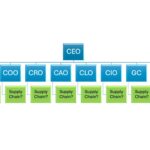Supply Chains in different industries have a lot in common – including price sensitivity, negotiations, the importance of resiliency, warehouse space issues (always either too much or too little), and the typical process of bid to purchase order to receipt. However, different industries have different considerations and tolerances beyond these basics. For a company sourcing food or medicine, perishability is a major consideration. For a consumer goods company in a fickle market like fashion, speed is of utmost importance. And for utility companies, the supply chain approach is primarily based on risk. As a supply chain practitioner in electric and gas utilities for over ten years, today I’m highlighting some of the things that make a utility supply chain unique. Highlighting these differences helps suppliers and internal utility practitioners better understand the motivations of their customers. As Simon Sinek says: Start with Why.
Risk Tolerance
As already noted, utilities have very low risk tolerance. Employees at every level of an electric utility understand that having the electric grid go out of commission puts lives at risk. Similarly, gas utility teams know that losing gas flow in the middle of a cold winter means customers freeze (see Texas in 2021). This is why utilities have extremely low tolerance for any risk. Specifically in supply chains, this means suppliers frequently have formal agreements governing supplier relationships, often many pages long. It means supplier award decisions take longer as technical and procurement teams deliberate over every decision. Lastly, it means utilities want materials manufactured as close to home as possible, and do not want the risks of an ocean crossing or foreign-made materials.
Supplier Implications: Be ready for long contracts, and be patient with award results. Focus on reducing risk for both parties in both proposals and contract negotiations to win business. Highlight the lower risk aspects of your bid (such as if all materials are quoted from domestic suppliers) to show value over cost.
Internal Implications: As with the suppliers, patience is key. Expect contracts to take longer, and focus on writing a good scope of work with clear criteria to speed up supplier evaluations. Clear go/no-go criteria de-risk a bid from the beginning and lead to better results.
Stability
Having been in place since the late 1800s (or longer in the case of water utilities), most utility companies don’t even talk about their founding date or how long they’ve been serving customers. Utility companies are exceptionally stable. While there are exceptions, for the most part utilities have steady demand from customers, and predictable cash flow. Even during the pandemic, there was a bit of a dip from industrial customers shutting down, but a portion was offset by the uptick in residential business as people were working from home. While other industries took a nosedive, people still wanted lights and air conditioning and heat and water, so utilities were relatively stable.
Supplier Implications: Once awarded business for a utility, sales are relatively predictable. If anything, recent legislation and large infrastructure projects are increasing utility demand for materials faster than ever before, and scarcity is a real issue in certain categories (as utility suppliers already know well).
Internal Implications: The dance partner to stability is complacency. This means bureaucracy, extra approvals (which remove accountability instead of adding it), and continuing to award to the same supplier over and over without checking the market. Keep an eye out for this kind of complacency and fight it everywhere you find it, regardless of your level in the organization. It costs the utility and external customers more money than most utilities realize.
Compliance
Most utilities have some variation on “regulatory compliance” in their core values or mission statements. Regulated utilities and the regulating bodies that govern them exist as a subtle, political tug-of-war. Investor-owned utilities especially are often seeking ways to push the boundaries of the regulations to increase profit, while regulatory bodies are under constant pressure from the public, environmental groups, and other non-government organizations to strengthen regulatory guidelines. Publicly-owned utilities and cooperatives also join this dance, but often seek more flexibility to work within the confines of the regulations. Bidding requirements to bid to three suppliers, for example, can cause issues in an industry with many monopolies and for projects that include products under patent.
Supplier Implications: If utilities are a primary customer, keep an eye on regulatory changes. This is related to risk, and to staying patient with seemingly slow decisions as utilities double check implications or approvals from regulatory bodies. Consider offering support in the form of lobbying assistance or public relations for mutual benefit.
Internal Implications: Ensure understanding of the procurement policy, which should be grounded in regulatory requirements. It is also ok to ask for the “why” of components of the policy that are overly cumbersome or seem counter to regulations, and to keep escalating and asking (politely). A good procurement team will be willing to get you the answers, and otherwise the procurement policy might need a bit of a revamp.
Inventory
Inventory is another place where utilities have some unique characteristics. Most non-utility companies seek to reduce inventory, keeping only what they need in order to boost cash flow. Regulated utilities can use Allowance for Funds Used During Construction, or AFUDC to recoup opportunity costs during construction projects. The interest rate is set, but basically it means that once materials for a construction project are purchased, the utility earns interest on its inventory. Unlike a manufacturer or consumer goods business, utilities are incentivized to receive and hold inventory ahead of a construction project like a plant or a large transmission line. That flips the typical supply chain approach to inventory turns on its head, largely invalidating any inventory reduction efforts.
Supplier Implications: Unlike manufacturers who penalize early deliveries, AFUDC means utilities will often take delivery of materials early. When possible, work with the procurement teams to see if that is the case so you can improve your own cash flow and still serve your utility customer.
Internal Implications: Inventory is a tricky one for supply chain professionals coming from other industries. Focus on Key Performance Indicators other than inventory, and leave an inventory reduction initiative for a last priority. Focus instead on working closely between procurement and the warehouse to manage physical space and keep inventory moving to laydown yards and other endpoints in construction.
Expense Capitalization
Utility companies strongly prefer to spend capital over ongoing operations and maintenance (O&M) costs. This is related to the regulatory compliance as regulators “reward” utilities for building capital infrastructure instead of ephemeral continuing costs to customers. Capital expenses allow for AFUDC and are allowable in rate cases, which is when regulated utilities are allowed to change what they charge customers (either up or down). This means that any time an expense can be moved from O&M to capital, a utility is likely to move it.
Supplier Implications: Maximize the “capital” aspect of your bids and minimize ongoing O&M charges. This especially applies to software licensing, implementation, and maintenance. In the rare case where software is bid, the winning bidder is likely to be the one who has the lower O&M cost to a utility. Move as much of your costs into the initial licensing and implementation as possible in order to minimize maintenance costs. Ensure your bid includes this “total cost of ownership” whether you are selling software or materials to highlight the overall lower cost of your product.
Internal Implications: Evaluate bids and suppliers on their total cost of ownership, and do so as fairly as possible. Consider the cost of O&M over the cost of capital in bid evaluations; the Finance team can help with these calculations and move the time value of money to the same point in time. At a recent conference, I sat at a table with a group of engineers discussing purchasing a large power transformer. Because of the ways each bidder structured their bid, they involved Finance to get the bids evaluated including the time value of money calculation and find the true best bid.
Supply Chain Departments
The most common way to organize a procurement department is by direct and indirect materials and services. Direct includes everything that goes into the product that goes to the customer, including raw materials and outsourced labor to construct the end product. Sometimes it also includes equipment maintenance, depending on the business. Indirect is simply everything else, including support services and employee benefits, facilities, fleet, and similar categories. In the utility industry, the customer “product” is electricity, gas, or water. While you can divide the utility plants into direct and indirect, it gets harder when considering a transmission or distribution line. Is cable line maintenance direct spend, or is it more like facilities and indirect? What about the fleet, including the trucks that install new poles and behave more like construction equipment than a fleet? In addition, most utilities do not divide procurement staff based on category, but instead still divide based on location or support team. A buyer may cover certain plants, or departments such as Substation Engineering. This increases internal customer service, but decreases the ability to leverage spend in the market and save costs. There is more on this topic in my article on centralized vs. decentralized teams.
Supplier Implications: Suppliers are less likely to have a single point of contact at a utility due to the more common organization structure based on location or department. Be prepared to deal with multiple contacts, and add value by helping the utility harmonize their orders. Especially for distributors, you add huge value and savings for both you and the utility when you gather together demand and go to your market with the combined value of all of the different utility’s departments. Highlight that value in bids and conversations with the utility supply chain team.
Internal Implications: Consider structuring your procurement team as “materials” and “services” instead of “direct” and “indirect.” This may make more intuitive sense for your business and will result in savings if you can align by category. While having a buyer for each department feels more comfortable, it also costs the business money and efficiency.
Outbound logistics
Because utilities don’t ship goods to customers, they have very minimal outbound logistics (and really it’s outbound to contractors or construction/laydown yards). Yet unlike a true services organization (like fintech or software), utilities do have inbound logistics. As a result, a utility will frequently let suppliers handle inbound logistics and put it out of mind. This results in rare “true supply chains”, and instead supply chain teams are focusing on procurement with warehouses reporting up through operations (skipping logistics teams entirely).
Supplier Implications: Chances are good your utility is having suppliers handle inbound logistics. To add value to your customer, work on consolidating loads to avoid partial truck load shipping. Consider when moving freight by rail is “fast enough” for the utility customer if that method is available on your logistics channels. If you are sending high volumes to the utility (such as with a major distributor), consider setting up more structured deliveries on set days of the week to allow for better load consolidation and warehouse flow.
Internal Implications: If you are currently letting suppliers handle all inbound logistics, consider contracting a third-party logistics (3PL) firm to handle load consolidation and help find better prices for shipping. If your suppliers are handling shipping, you are paying top dollar for your logistics and probably not taking advantage of any efficiencies in that space. If you are quoting materials with “shipping included” to make shipping fees “zero”, you are also probably paying taxes you shouldn’t be on those shipping fees.
The risk and regulatory approach, inventory rules, prioritization on capital vs. O&M, and supply chain structure all make the utility industry a bit different when it comes to approaching their supply chains. Hopefully this article has been helpful in offering practical advice for professionals both in and serving utility supply chains, and if you’d like to have a longer conversation let’s set up a time to chat.




